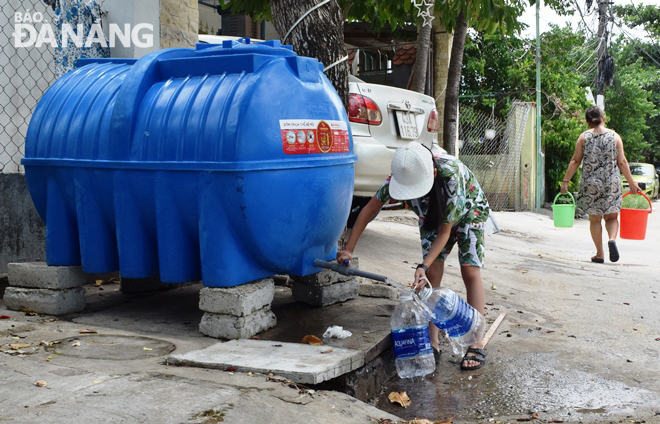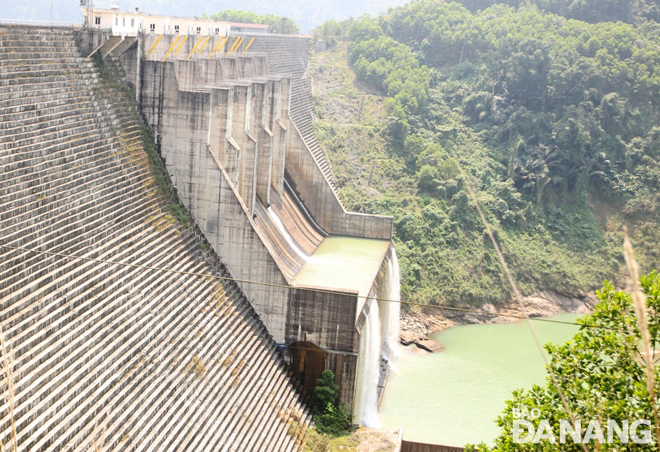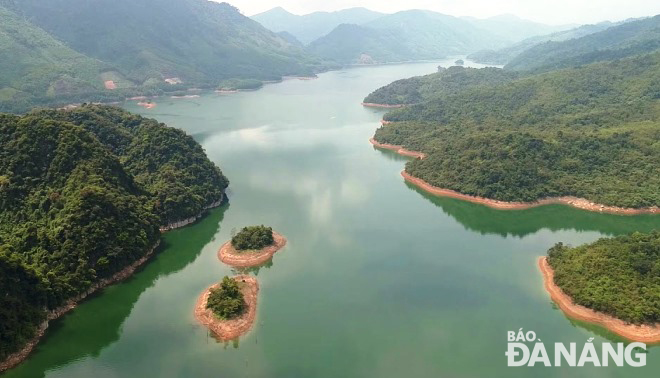Severe water shortage faces city, hydropower plants agree on water discharges
The A Vuong and Dak Mi 4 hydropower plants have agreed on around-the-clock water discharges from their reservoirs into the downstream of the Vu Gia River whose tributary flows into the severe salinity-affected Cau Do (Red Bridge) River.
 |
| Residents in Ngu Hanh Son District are taking water from DAWACO-provided water tanks. |
In recent days, the severe shortage of tap water and reduction in water pressure in many of Da Nang’s parts has turned locals’ daily lives upside down in the face of the current salt-water contamination in the Cau Do River.
Tuesday saw weak water pressure and water scarcity in the districts of Son Tra, Ngu Hanh Son, Hai Chau and Thanh Khe, although water plants have been operated at full capacity.
The water scarcity has prompted the Da Nang Water Supply Company (DAWACO) to conduct the rotational water supply schedules for parts of the city, and encourage local residents to use water sparingly.
As a temporary measure to alleviate any issues brought about by the ongoing water shortage, DAWACO has deployed a number of mobile water supply vehicles and water tanks to local residential areas affected by water cuts over recent days.
In particular, DAWACO also suggested the municipal Department of Police assigned its fire trucks to transport water to the Da Nang General Hospital.
It is reported that, the A Vuong hydropower reservoir has the current capacity of about 40 million m3 of water.
 |
| The Dak Mi 4 hydropower reservoir will release water at a daily capacity of 25 m3/s in order to push salinity out of the Cau Do River. |
At Wednesday’s meeting with the city leaders, representatives from the A Vuong hydropower plant pledged that its reservoir will discharge water at a maximum daily capacity of over 70m3/s, about 6 million m3 of water per day, in order to push salinity out of the Cau Do River. In a similar vein, the Dak Mi 4 hydropower reservoir will release water at a daily capacity of 25 m3/s.
This positive sign is highly expected to facilitate the Cau Do and International Airport water supply plants to fetch water source for production in order restore water supplies for the whole city.
 |
| The A Vuong hydropower reservoir will discharge water at a maximum daily capacity of over 70m3/s, about 6 million m3 of water per day. |
Also, it is necessary for DAWACO to have its pipeline system completed no later than 1 September to source more water from the city-based An Trach Dam.
Meanwhile, the above-mentioned hydropower plants will ask for permission from the National Load Dispatch Centre (NLDC) to conduct 24-hour emergency water discharges.
The city has been repeatedly battered by prolonged heatwaves and a shortage of rain since February, which resulted in serious drought and saltwater intrusion in many rivers.
This year is witnessing a more severe salt-water contamination in comparison with last year. It is worth noting that, last month, the salinity level in the Cau Do River set a record high of 4,411 mg/l, much higher than the permitted levels, hereby hindering the intake of raw water at the Cau Do water plant.
DAWACO has underlined an urgent need to construct an about 200m-long temporary water dam, about 3.5 km from the downstream section of the Cau Do Bridge in order to prevent saline intrusion and ensure raw water supplies to the namesake water plant.
Also on Wednesday, the municipal administration issued written request to the Ministry of Natural Resources and the Environment and the Quang Nam Provincial People's Committee on the implementation of the national government-approved inter-reservoir operating procedures at the Vu Gia - Thu Bon river basin until the end of the ongoing dry season. The focus is on asking for a nod to water discharges by the 2 hydropower plants. The intention is to ensure the sufficient water supply for the daily lives, and the agricultural and industrial production activities, of local citizens.








